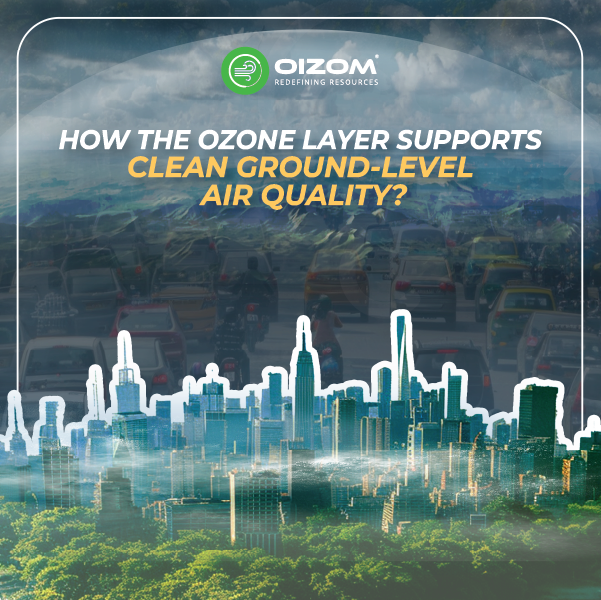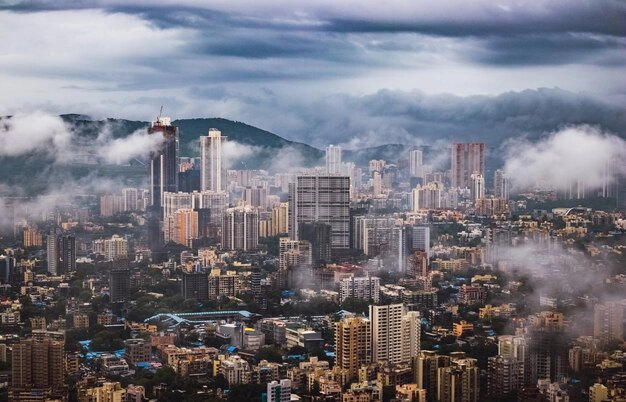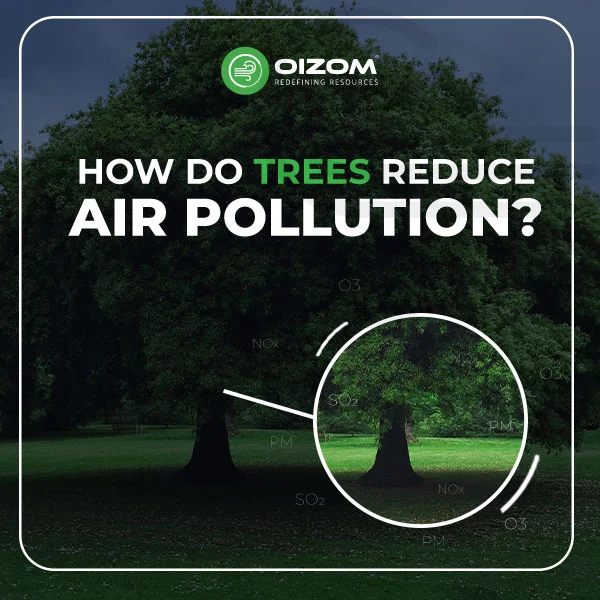Summary
Ozone plays a dual role in Earth’s atmosphere, providing valuable protection at high altitudes while being a vital air quality concern at lower altitudes. The blog explores this double identity by discussing how the stratospheric ozone layer protects us from UV radiation, how ozone formed at the terrestrial boundary is the result of photochemical reaction, and how ozone is an important indicator of urban and regional air quality distress. The blog also highlights key characteristics of ozone through real-time monitoring. Ultimately, the discussion examines potential health, environmental, and material outcomes of adoptable elevated ozone levels.
How the Ozone Layer Supports Clean Ground-level Air Quality?
Ozone is one such rare atmospheric element that acts in two opposing ways simultaneously. The same molecule that shields us from harmful UV radiation in the stratosphere can become a reactive pollutant near the surface, affecting daily smog levels and long-term environmental health. Understanding how these layers interact, how sunlight affects ozone chemistry, and how monitoring reveals its real-world behaviour is crucial to understanding modern air quality. As global discussions on climate, pollution, and atmospheric protection increase, exploring ozone’s dual identity becomes a necessary foundation for understanding what clean air truly means today.
What is the Ozone Layer and Ground-Level Ozone?
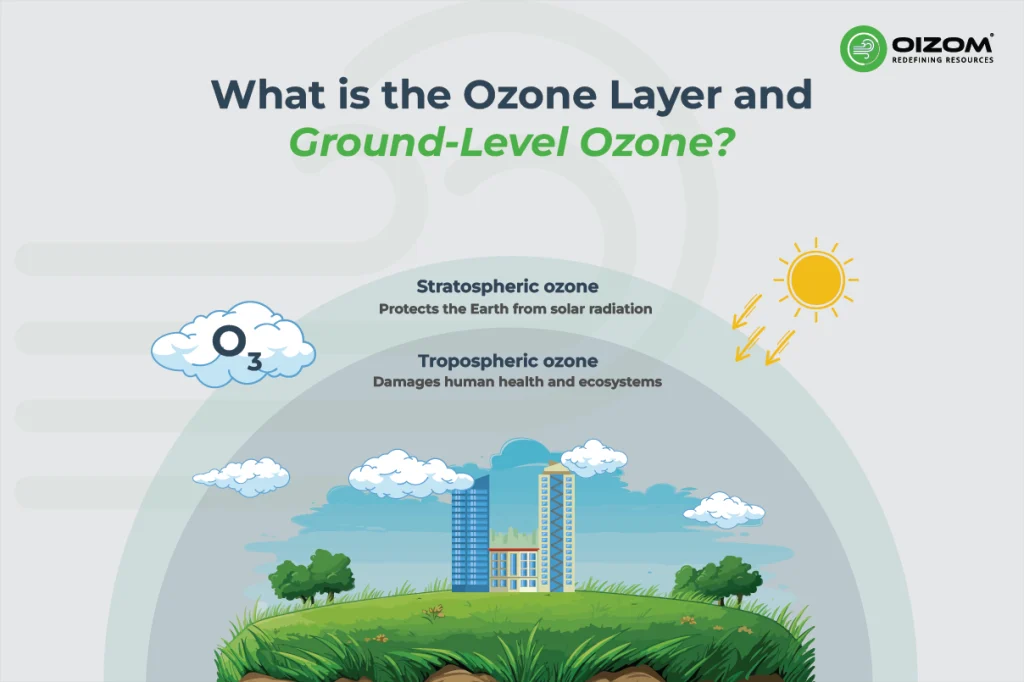
The specialty of Ozone (O₃) lies in its location; the significance of ozone differs depending on its location in the atmosphere. Ozone in the stratosphere, at approximately 10 to 50 kilometers up, forms a layer that protects the Earth from the sun’s harmful UV radiation by absorbing a large percentage of the sun’s ultraviolet energy. This natural barrier is crucial in promoting environmental stability, reducing UV exposure, and enabling life on Earth to thrive.
Ground-level ozone, also known as tropospheric ozone, is, however, a product of the chemical reactions between nitrogen oxides (NOₓ), volatile organic compounds (VOCs), and sunlight. Unlike the layers of ozone in the stratosphere, ground-level ozone is a pollutant that causes smog, irritating the respiratory system, damaging plants by stressing the vegetation, and altering and restructuring the larger atmospheric chemistry. A good way to think about this is with a simple “address” analogy: the same molecule acts as a protective shield at its higher address in the stratosphere, which is not true at its lower address near the surface for the ground-level version of the same molecule.
How Does the Ozone Layer Help Maintain Ground-level Air Quality?
The ozone layer indirectly affects the quality of air at ground level through its effects on how much high-energy UV radiation passes into the lower atmosphere. By absorbing UV-B and UV-C, it reduces or prevents key photochemical reactions (such as NO₂ photolysis, OH radical production, and the chain reactions that produce ground-level ozone and other secondary pollutants) from occurring. These reactions would otherwise cause the atmosphere to become increasingly reactive, increasing the potential for the rapid formation of smog and excessive oxidation of VOCs, which would otherwise aggravate surface-level pollution.
Additionally, from a non-chemical perspective, the ozone layer moderates stratospheric temperature gradients, which impact large-scale circulation patterns and influence how air pollutants accumulate or disperse near the ground. The weakening of the ozone layer can cause a change in these gradients that alters weather behaviour, resulting in the potential to increase stagnation, trapping air pollutants for a longer period. The international success of the Montreal Protocol has had a significant indirect benefit, halting ozone depletion globally. It has effectively prevented increased UV penetration and associated atmospheric instability that would have aggravated air quality at ground level around the world.
What Air Quality Monitoring Tells Us About Ozone’s Effects?
The air quality monitoring directly informs us about the behavior of ozone in real-time, highlighting behavior not available through estimates and static models. Continuous measurements reveal how ozone concentration rises and declines throughout each day, often increasing during the afternoon when NO₂ photolysis and VOC oxidation are driven by sunlight, and then declines overnight as these rates slow and ozone is consumed by NO or through surface deposition. These diurnal patterns allow monitoring networks to determine if a region is operating in a NOx-limited or VOC-limited regime, which is critical information for whether reducing vehicle or industrial VOC emissions, or both, will lead to meaningful reductions in ozone.
Additionally, monitoring reveals the limitations of atmospheric models, as ozone formation occurs in complex ways influenced by local weather, boundary-layer behavior, precursor levels, and surface conditions that models often oversimplify. Real-time monitoring helps identify deviations, unexpected heatwave spikes, unusually low levels during the monsoon, and fluctuations due to traffic and industrial activity, which refine forecasting and inform policy decisions. Lacking continuous data about ozone levels, decision-makers risk misjudging the emission sources causing exceedances, or how effective mitigation efforts are.
Health and Environmental Effects Linked to Ozone and Air Quality
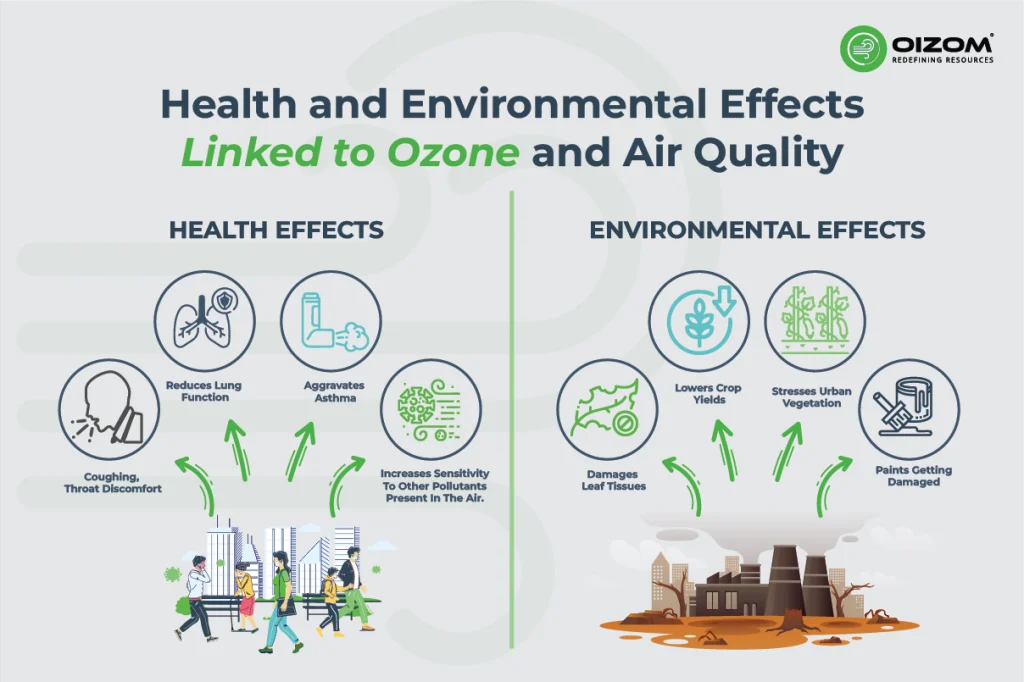
Health Effects
- Irritates the respiratory system, causing coughing, throat discomfort, and chest tightness.
- Reduces lung function and makes physical activity difficult.
- Aggravates asthma and increases airway inflammation with repeated exposure.
- Increases sensitivity to other pollutants present in the air.
Environmental Effects
- Damages leaf tissues and reduces photosynthesis in plants.
- Lowers crop yields and affects forest and agricultural productivity.
- Stresses urban vegetation and peri-urban green belts.
- Accelerates the deterioration of materials such as rubber, paints, and surface coatings, thereby shortening the life of infrastructure and equipment.
Effective Ways to Tackle Ozone Protection and Air Quality Issues
- Tighten control on NOx and VOC emissions, as these are the primary precursors contributing to the formation of ground-level ozone. This is achieved through cleaner transportation technology, stricter management of industrial solvents, and improved combustion efficiency across all sectors.
- Deploy energy systems that limit high-temperature combustion to minimise the release of ozone precursors as well as long-lived pollutants that can indirectly affect stratospheric chemistry. Transition to renewables and low-emission fuels serving both air quality and climate stability in the upper atmosphere.
- Implement substantial management of refrigerants and chemicals, while adhering to international phase-down targets that apply to both ozone-depleting substances and high-GWP substitutes.
- Adapt urban design and heat management. Increasing greenery in urban areas, employing reflective pavement, and constructing heat-resistant infrastructure can all help to minimize peak ozone levels at the local level.
- Improve process controls in the industry and containment of solvents, as fugitive emissions are a primary source of ozone precursors. Upgrading process systems and adopting closed-loop or low-VOC technology might introduce longer-term solutions.
- Improve real-time monitoring and public information systems that would allow for greater identification of ozone build-up during peak summer months, allowing for the scheduling of traffic restrictions, modification of industrial activity, or alerts during peak photochemical times.
How Oizom Supports Ozone and Air Quality Monitoring Efforts
Oizom enhances ozone and wider air quality management through precise, real-time monitoring. Devices such as the Polludrone provide accurate measurements of ground-level ozone (O₃), NOx, VOCs, and particulates, allowing users to monitor photochemical behavior and identify pollution as emissions accumulate in real-time. Coupled with Oizom’s Envizom software, the sensors translate raw data into partial insights on diurnal behaviour, precursor correlations, and changes in emerging ozone trends. The combination of robust hardware and dependable analytics gives organizations the visibility and confidence needed to make timely, data-driven decisions that strengthen ozone management and air quality.
Conclusion
Ozone is an example of how a single molecule can be either a global protector or a local pollutant, depending on its location and context. Learning chemistry is important, but we also get to learn more about its health and environmental effects, and the patterns that emerge over time from visible monitoring, if that is what is really driving air quality on the ground. With ongoing global actions to protect the ozone layer and the advancement of technologies to track surface ozone more accurately, tools like the Polludrone Air Quality Monitoring System are helping cities and industries make informed, data-driven decisions that strengthen air-quality management efforts. Ultimately, understanding ozone behaviour is a fundamental step in developing healthier, more resilient atmospheric conditions in the future.
FAQs
The ozone layer protects life by absorbing harmful UV radiation, while ground-level ozone forms from pollutants and acts as a toxic air pollutant.
Ozone pollution irritates the respiratory system, damages vegetation, reduces crop yields, and accelerates material degradation.
Air quality monitoring tracks ground-level ozone but requires specialised satellite or stratospheric instruments to detect changes in the ozone layer.

